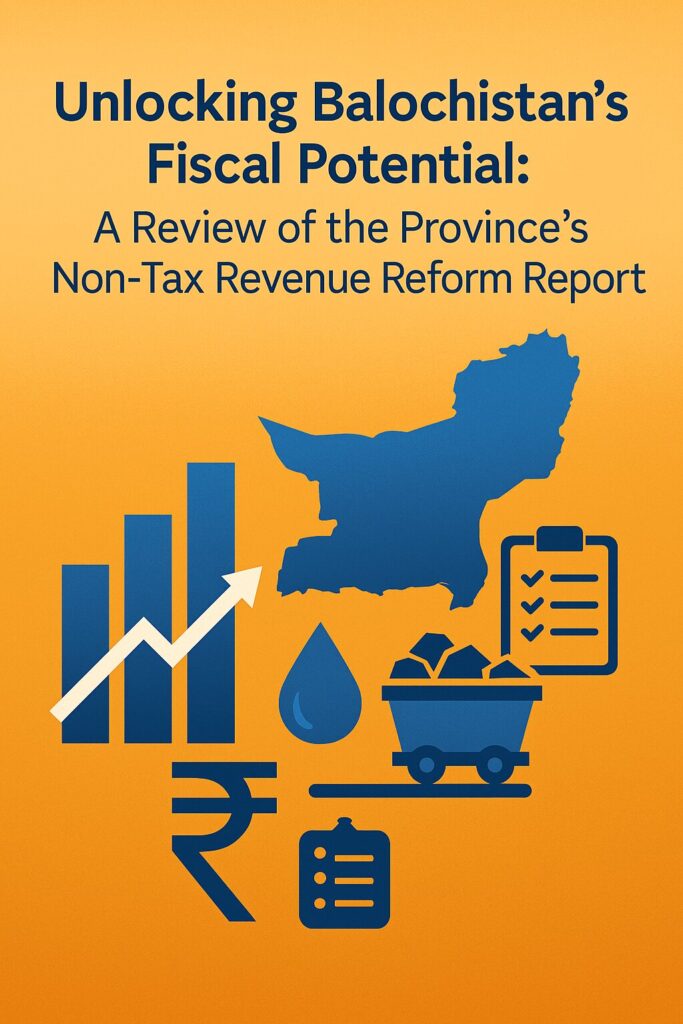
The Government of Balochistan’s Finance Department, with support from the World Bank’s Governance and Policy Project (GPP), released a final assessment report in late 2024 to revamp the province’s non-tax revenue (NTR) streams. This report forms a core part of the Non-Tax Revenue Mobilization Strategy (NTRMS), targeting the province’s reliance on federal transfers and taxes by unlocking untapped local revenue potential. In a region marked by vast mineral wealth and strategic geography but underdeveloped public services, effective NTR mobilization is critical.
According to the report, Balochistan collected just PKR 8.3 billion in NTR during FY2022–23, constituting a mere 4.2% of its total revenue receipts. This is significantly lower than Punjab and Sindh, which collected approximately PKR 46 billion and PKR 38 billion respectively in the same year, with NTR making up around 7–10% of their receipts. Even Khyber Pakhtunkhwa, with fewer service-based revenue streams than the southern provinces, outperformed Balochistan in proportional terms. This stark difference underscores both the existing gap and the potential upside for Balochistan.
The report provides a detailed breakdown of the province’s NTR sources. The highest contributors are mineral royalties (about PKR 2.4 billion), lease charges on government land (PKR 1.2 billion), water user charges (PKR 900 million), and administrative fees and fines across departments. Alarmingly, over 60% of departments use outdated fee schedules—some more than 15 years old—and a significant share of collections are conducted manually without proper reconciliation.
Quantitative projections in the report estimate that modernizing and indexing all departmental fee structures could raise an additional PKR 3.5 to 4.5 billion annually. Enhanced enforcement of lease recovery—especially for land used by commercial and agro-industrial entities—has the potential to yield another PKR 1.5 billion per year. If mining royalty evasion is curtailed through digitized tracking of output and market-linked royalty valuation, the province could generate an additional PKR 2 billion annually.
The strategy recommends the adoption of an integrated digital revenue platform, linking departmental billing with a centralized treasury system. It also proposes the creation of a Non-Tax Revenue Reform Cell within the Finance Department, mandated to oversee reforms, provide technical support to departments, and report progress quarterly to the provincial cabinet.
While the report is strong on revenue diagnostics and forecasts, it is relatively silent on the political and administrative challenges. Many departments in Balochistan operate with significant autonomy over their revenue streams and may resist attempts to centralize receipts. Additionally, raising user charges—especially in education, health, and water supply—may attract public opposition in districts with high poverty and low service coverage.
The report suggests capacity-building as a foundational reform, yet it does not specify which departments require institutional upgrades, what training modules should be introduced, or how service delivery staff will be incentivized to align with the new revenue system. A clearer costing and phasing plan, identifying short-, medium-, and long-term priorities, would help in prioritizing reforms and budgeting technical assistance.
The comparative data across provinces—combined with departmental-level inefficiencies revealed in the assessment—makes a compelling case for urgent reform. For example, while Punjab has revised its Schedule of Fees for over 60 departments in the past five years, Balochistan has updated only 12 departmental fee schedules since 2010. Sindh has already introduced a digital NTR dashboard, whereas Balochistan is still at the concept stage.
In conclusion, the GPP-supported NTRMS Final Report offers a robust technical roadmap for reforming Balochistan’s non-tax revenue system. However, success will ultimately hinge on political commitment, interdepartmental cooperation, and citizen engagement. If pursued seriously, the proposed reforms could more than double Balochistan’s NTR in five years—generating fiscal space for critical investments in health, education, and infrastructure, and reducing dependency on Islamabad. The opportunity is real; what remains is the political will to act.
This Article was published at www.publicfinance.pk.
